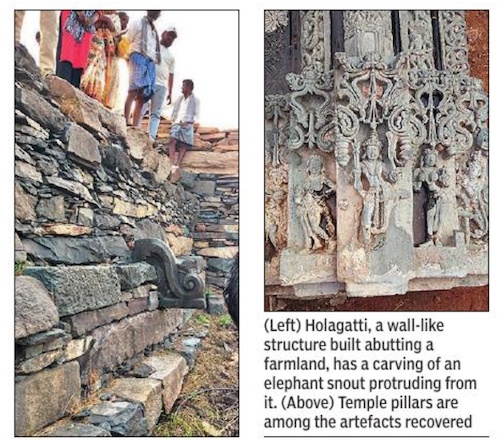Lakkundi
Lakkundi
This article has been extracted from THE IMPERIAL GAZETTEER OF INDIA , 1908. OXFORD, AT THE CLARENDON PRESS. |
Note: National, provincial and district boundaries have changed considerably since 1908. Typically, old states, ‘divisions’ and districts have been broken into smaller units, and many tahsils upgraded to districts. Some units have since been renamed. Therefore, this article is being posted mainly for its historical value.
Place of antiquarian interest in the Gadag taluka of Dharwar District, Bombay, situated in 15"^ 23' N. and 75° 43' E., 7 miles south-east of Gadag town. Population (1901), 4,454. It contains fifty temples and thirty-five inscriptions. The temples are ascribed to Jakhanacharya. They suffered severely in the Chola invasion about 1070, but were afterwards rebuilt. The finest and most remarkable is the temple of Kashivishveshwar. There are numerous step-wells. Of the thirty-five inscriptions, the earliest deciphered is dated a.d. 868. In 1192 the Hoysala king Ballala II, better known as Vira Ballala (i 192-12 11), established his capital at Lakkundi, then styled Lokkigundi, and in the vicinity met and defeated the forces of the Deogiri Yadava Bhillam, commanded by the latter's son Jaitugi. Lakkundi contains a school.
A backgrounder
As of 2024
Pearl Dsouza, Dec 10, 2024: The Times of India

From: Pearl Dsouza, Dec 10, 2024: The Times of India
Bengaluru : For Lakkundi, a village in Karnataka’s Gadag district, the past is not just history — it’s a living, breathing legacy waiting to be preserved. Inone recent memorable instance, an epigraphist descended into a pit to examine a newly unearthed 8-foot, 12th-century stone tablet. Scrubbing white powder into its Halegannada (old Kannada) inscription, he deciphered its cryptic warning: “Preserve me or face wrath.” The villagers gathered around the pit and responded with cheers, marvelling at this tangible connection to their heritage.
Later, the epigraphist explained to TOI: “The inscription on the tablet is fragmented. The context is not clearly known. What can be understood is that saving the shasana (tablet) entails blessing, not saving it can lead to destruction.” About 400km from Bengaluru, the village is dotted with ancient temples, stepwells, and relics showcasing the grandeur of bygone eras. Also known as Lokkugundi, it hosted a gold coin mint during the era of the Chalukyas of Kalyani.
From Nov 22, the state department of archaeology, museums, and heritage launched a three-day relic-discovery drive, bringing together villagers, historians, and officials to unearth its treasures.
The drive concluded in a carnival-like celebration. Villagers, students, and folklore artists joined in a jubilant procession through Lakkundi. Women carried metal pots on their heads, folk mu- sicians played shehnai, and dancers performed the traditional dollu kunitha.
Residents also turned over personal treasures, including coins, stone carvings, and ancient relics from their homes and attics, some dating back to the Rashtrakuta, Chalukya, Hoysala, and Vijayanagara periods. Govt incentivised their participation with cash prizes of Rs 25,000, Rs 15,000, and Rs 10,000 for the most valuable artefacts.
Among the discoveries was a wall-like structure, locally known as Holagatti, built to prevent farmland erosion. Carved with an elephant snout and featuring an idol on its pedestal, this ravine reclamation structure has caught the attention of authorities, who are debating whether to relocate the entire structure to a preservation site or move its key elements.
The drive also uncovered five temples that had been repurposed into residential homes. One such house, owned by 70-year-old Veerayya Panchaksharaiyya Kalmath, was handed over to govt for restoration, although the family is anxious about future housing arrangements.
“We were promised monetary compensation, but we’re unsure where we’ll go after we vacate,” Veerayya said.
District in-charge minister HK Patil assured residents. “We honour those who hand over artefacts. For families vacating heritage sites, we will provide financial assistance or alternative plots as needed,” he said. “Collecting artefacts is the first step. By Dec-end, we’ll start excavation wherever needed.” Plans are underway to create a museum for the collected artefacts and to reconstruct temples using 11thand 12th-century pillars.